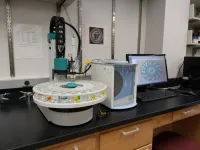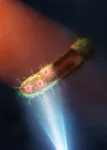(Press-News.org) PULLMAN, Wash. – While the electronic tongue bears little physical resemblance to its namesake, the strand-like sensory probes of the “e-tongue” still outperformed human senses when detecting contaminated wine in a recent study.
In an experiment at Washington State University, the e-tongue identified signs of microorganisms in white wine within a week after contamination—four weeks before a human panel noticed the change in aroma. This was also before those microbes could be grown from the wine in a petri-dish. Winemakers traditionally rely on these two methods, sniffing the wine and petri-dish testing, to identify potential wine “faults” or spoilage.
The findings, detailed in the Journal of Food Science, indicate that e-tongue testing could augment those methods and allow winemakers to catch and mitigate problems sooner, said Carolyn Ross, WSU food science professor and the study’s corresponding author.
“If you ran a sample using the electronic tongue, we could learn after one week if there’s contamination or a wine fault problem, versus waiting up to four weeks running just sensory testing,” said Ross, who is also the director of WSU’s Sensory Science Center. “It's really helpful with understanding wine quality.”
When immersed in a liquid, the e-tongue’s sensors can “taste” it by analyzing for the presence of certain compounds. At WSU, Ross’ team developed and programmed the instrument for various purposes including taking a type of “fingerprint” of wine, collecting a variety of information that may be of interest to winemakers.
“It gives good information about the holistic quality of the wines,” Ross said, though she noted that this type of analysis is best used to complement, not replace, other methods of judging wine quality.
In this study, the researchers purposely added four microbes to different bottles of Reisling. These microbes are known to contaminate white wine, causing spoilage and unpleasant odors, including nail polish remover, geranium and “mousy” odors. They trained a group of 13 volunteers to recognize a range of wine attributes by their aromas, both positive and negative, including these odors.
The trained panel then assessed the aroma of uncontaminated wine as a control and samples of the contaminated wine that had been stored for seven days to 42 days. The e-tongue was set to the same task and identified the contamination of all types after the first seven days of storage. The human sensory panel only started to detect contamination in some of the samples after 35 days of storage, a full 28 days after the e-tongue.
Ross and her colleagues have also tested out the e-tongue with red wine in an earlier study, and the team is continuing to develop the instrument housed at the WSU Sensory Science Center, building up a library to help inform its “tasting” abilities. Ross is currently looking for winery clients interested in the e-tongue capabilities to help assess the quality of their products.
This study received support from the Washington Wine and Grape Research fund and the U.S. Department of Agriculture. Additional co-authors on the study include first author Rachel Potter and Claire Warren of WSU and Jungmin Lee of the U.S.D.A. Agricultural Research Service.
END
E-tongue can detect white wine spoilage before humans can
2024-04-17
ELSE PRESS RELEASES FROM THIS DATE:
Adults with congenital heart disease faced higher risk of abnormal heart rhythms
2024-04-17
Research Highlights:
Almost 1 in 5 adults with congenital heart disease living in Israel had or developed an abnormal heart rhythm over five years.
Adults with congenital heart disease who developed an irregular heart rhythm in the heart’s upper chambers faced a 65% increased risk of premature death.
The adults who developed an irregular heart rhythm in the heart’s lower chambers had double the risk of premature death.
Embargoed until 4 a.m. CT/5 a.m. ET Wednesday, April 17, 2024
DALLAS, April 17, 2024 — Almost 1 in 5 adults with congenital heart disease living in Israel had or developed an abnormal ...
A better view with new mid-infrared nanoscopy
2024-04-17
A team at the University of Tokyo have constructed an improved mid-infrared microscope, enabling them to see the structures inside living bacteria at the nanometer scale. Mid-infrared microscopy is typically limited by its low resolution, especially when compared to other microscopy techniques. This latest development produced images at 120 nanometers, which the researchers say is a thirtyfold improvement on the resolution of typical mid-infrared microscopes. Being able to view samples more clearly at this smaller scale can aid multiple fields of research, including into infectious diseases, and opens the way for developing ...
New study uncovers why boys born to mothers with HIV are at greater risk of health problems and death in infancy
2024-04-17
Researchers have found that children of women with HIV infection have an increased risk of immune abnormalities following exposure to maternal HIV viraemia, immune dysfunction, and co-infections during pregnancy.
The study, led by Dr Ceri Evans while at Queen Mary University of London, compared clinical outcomes between infants who were HIV-exposed and HIV-unexposed in the Sanitation Hygiene Infant Nutrition Efficacy (SHINE) trial in rural Zimbabwe. Despite high coverage of maternal antiretroviral therapy (ART) and uptake of exclusive breastfeeding, mortality in infants exposed to HIV was 41% higher than in infants not exposed to HIV. Infants who survived and remained HIV-free ...
Interspecies competition led to even more forms of ancient human – defying evolutionary trends in vertebrates
2024-04-17
Competition between species played a major role in the rise and fall of hominins – and produced a “bizarre” evolutionary pattern for the Homo lineage – according to a new University of Cambridge study that revises the start and end dates for many of our early ancestors.
Conventionally, climate is held responsible for the emergence and extinction of hominin species. In most vertebrates, however, interspecies competition is known to play an important role.
Now, research shows for the first time that competition was fundamental to “speciation” – the rate at which new species emerge ...
First new analysis in three decades identifies which treatments for the long-term effects of malnutrition could help reduce mortality and poor health outcomes for children
2024-04-17
A comparison of treatments for malnutrition enteropathy, caused by severe acute malnutrition (SAM), has found evidence supporting the use of treatments to enhance the healing of mucosal membranes and reduce inflammation in the gut to improve the outcomes of children affected by long-team health consequences of a period of malnutrition.
The Therapeutic Approaches to Malnutrition Enteropathy (TAME), led by researchers from Queen Mary University of London, evaluated four interventions for malnutrition enteropathy in a multi-centre phase ...
AI speeds up drug design for Parkinson’s by ten-fold
2024-04-17
Researchers have used artificial intelligence techniques to massively accelerate the search for Parkinson’s disease treatments.
The researchers, from the University of Cambridge, designed and used an AI-based strategy to identify compounds that block the clumping, or aggregation, of alpha-synuclein, the protein that characterises Parkinson’s.
The team used machine learning techniques to quickly screen a chemical library containing millions of entries, and identified five highly potent compounds for further investigation.
Parkinson’s affects more than six million people worldwide, with that number projected to triple by 2040. ...
Older adults with diabetes experienced functional decline during the COVID-19 pandemic
2024-04-17
Toronto, ON —Researchers found that approximately 1 in 5 older Canadian adults with diabetes and no pre-pandemic functional limitations developed functional limitations for the first time during the COVID-19 pandemic. Functional limitations refer to difficulties with basic mobility-related tasks, such as walking two to three blocks, standing up from a chair, or climbing stairs. In comparison, only one in eight of their peers without diabetes developed functional limitations during the ...
How soil microbes survive in harsh desert environments
2024-04-17
Prolonged droughts followed by sudden bursts of rainfall – how do desert soil bacteria manage to survive such harsh conditions? This long-debated question has now been answered by an ERC project led by microbiologist Dagmar Woebken from the Centre for Microbiology and Environmental Systems Science (CeMESS) at the University of Vienna. The study reveals that desert soil bacteria are highly adapted to survive the rapid environmental changes experienced with each rainfall event. These findings were recently published in the prestigious ...
Toronto researchers uncover human DNA repair by nuclear metamorphosis
2024-04-17
Researchers at the University of Toronto have discovered a DNA repair mechanism that advances understanding of how human cells stay healthy, and which could lead to new treatments for cancer and premature aging.
The study, published in the journal Nature Structural and Molecular Biology, also sheds light on the mechanism of action of some existing chemotherapy drugs.
“We think this research solves the mystery of how DNA double-strand breaks and the nuclear envelope connect for ...
Fluctuating coffee prices put mental pressure on Vietnamese farmers
2024-04-17
While your invigorating morning coffee may become cheaper when there are large fluctuations in the world market price, they are a major additional psychological burden for the farmers who grow the coffee.
This is documented in a new international study on the effect of income uncertainty on the mental health of Vietnamese coffee farmers.
"Our results suggest that not only poverty, but also the risk of poverty caused by fluctuating prices has a significant additional negative effect on the mental well-being of farmers in low-income countries," says Finn ...




